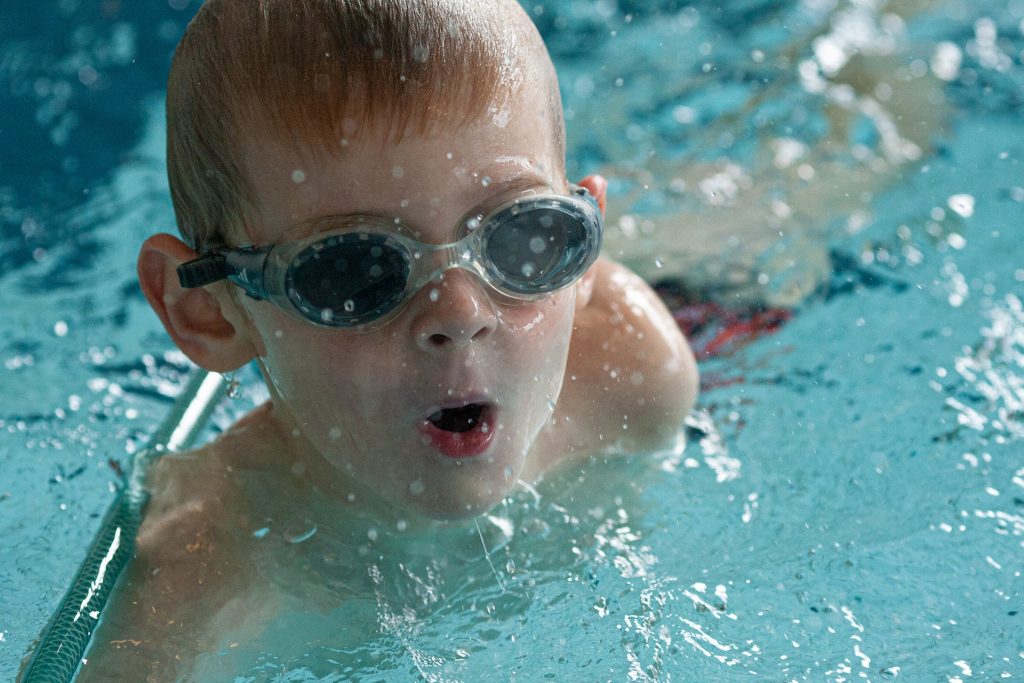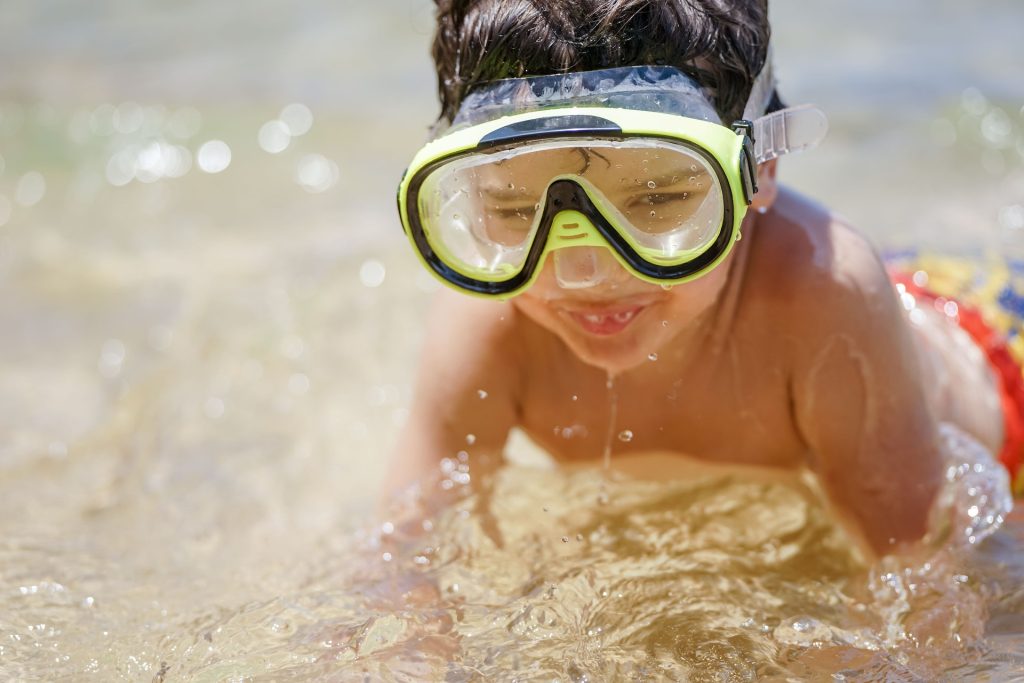Discover effective strategies and techniques for teaching swimming to 5-6 year old children.
How to Teach Swimming to a 5-6 Year Old Child
Swimming is not only a fun activity; it’s also an essential life skill. Teaching a 5-6 year old child how to swim can be an exciting and rewarding experience. However, it’s important to understand the developmental stage of a child in this age range to ensure effective teaching and a positive learning experience. Let’s dive into the physical and cognitive abilities of 5-6 year olds and their emotional and social readiness for swimming lessons.
Understanding the Developmental Stage of a 5-6 Year Old Child

Physical and Cognitive Abilities of 5-6 Year Olds
At this age, children are becoming more coordinated and confident in their physical abilities. They have better control over their arms and legs, making it easier for them to learn and practice swimming techniques. Not only are they able to kick and paddle more effectively, but they also have improved balance and coordination in the water. This newfound physical prowess opens up a world of possibilities for their swimming abilities.
It’s important to take advantage of their growing motor skills and introduce them to various movements and exercises in the water. By incorporating activities that focus on body awareness and control, such as floating on their backs or performing different strokes, you can help them develop a strong foundation for future swimming skills. These activities not only enhance their physical abilities but also promote their overall health and well-being.
Additionally, their cognitive abilities are also expanding at this stage. They can understand and follow simple instructions, making it easier to teach them swim-related concepts and techniques. Their ability to comprehend and apply new information allows for more structured and focused swimming lessons. You can introduce them to concepts like breathing techniques, body positioning, and water safety rules.
By incorporating fun and engaging activities into your swimming lessons, you can help enhance their cognitive development while they learn the basics of swimming. For example, you can play games that involve counting or identifying colors to reinforce their cognitive skills. These activities not only make the learning process enjoyable but also stimulate their mental growth.
Emotional and Social Readiness for Learning to Swim
Before starting swimming lessons, it’s crucial to assess a child’s emotional and social readiness. Some children may feel anxious or fearful around water, while others may be more confident. Each child’s emotional journey is unique, and it’s important to acknowledge and respect their individual experiences.
Creating a safe and supportive environment is vital to ensure their emotional well-being throughout the learning process. By establishing trust and open communication, you can help them feel secure and comfortable in the water. Take the time to talk to the child about their feelings and address any fears or concerns they may have. Encourage them to express themselves and assure them that you will be there to support and guide them every step of the way.
Building trust and reducing fear is key to creating a positive learning experience and nurturing their love for swimming. As they overcome their initial apprehensions, they will develop a sense of confidence and accomplishment. This newfound emotional resilience will not only benefit them in the water but also in other aspects of their lives.
Furthermore, learning to swim also provides an opportunity for children to develop their social skills. Group swimming lessons allow them to interact with their peers, fostering teamwork, cooperation, and empathy. They learn to take turns, support each other, and celebrate each other’s achievements. These social interactions contribute to their overall social and emotional development, helping them build lasting friendships and a sense of belonging.
Creating a Safe and Supportive Environment
Choosing the Right Swimming Location
When teaching a child to swim, selecting the right swimming location is paramount. Look for a pool or swimming area that is specifically designed for children and offers a safe environment. Ensure that the water is clean and at an appropriate temperature for comfort.
Consider the size and depth of the pool, as well as the availability of qualified lifeguards or instructors. Having knowledgeable professionals on hand will provide an extra layer of safety and give you peace of mind during the lessons.
Furthermore, it is important to choose a swimming location that is conducive to learning. Look for a facility that has a designated area for beginners, with shallow water and gradual depth progression. This will allow the child to gradually build their confidence and skills as they become more comfortable in the water.
Another aspect to consider is the overall atmosphere of the swimming location. Look for a place that promotes a positive and supportive environment. This can be reflected in the attitudes and behaviors of the staff and other swimmers. A welcoming and encouraging atmosphere will help the child feel more comfortable and motivated to learn.
Ensuring Proper Supervision and Safety Measures
Proper supervision is crucial when teaching swimming to young children. Always ensure that there is adult supervision present, regardless of the child’s swimming ability. Constant vigilance is important to prevent accidents and respond quickly in case of emergencies.
In addition to adult supervision, it is important to establish clear rules and guidelines for behavior in and around the water. Teach the child about the importance of following these rules to ensure their safety and the safety of others. Reinforce these rules consistently and make sure the child understands the consequences of not adhering to them.
Additionally, make sure to implement safety measures such as providing life jackets or floatation devices, especially during the initial stages of learning. These will help build the child’s confidence in the water and serve as a safety net as they develop their swimming skills.
Furthermore, consider enrolling the child in swimming lessons that focus on water safety and survival skills. These lessons will not only teach the child how to swim but also educate them about potential dangers in and around the water. They will learn important skills such as how to float, tread water, and safely exit the pool or body of water in case of an emergency.
Lastly, it is important to regularly assess and update the safety measures in place. As the child progresses in their swimming abilities, adjust the level of supervision and gradually reduce the reliance on floatation devices. Continuously evaluate the swimming location and its facilities to ensure that they meet the necessary safety standards.
Introducing Water and Building Confidence

Familiarizing the Child with Water
A great way to start teaching swimming to a 5-6 year old child is by familiarizing them with water. Begin with activities that allow them to explore the water while feeling supported and safe. Encourage them to splash, play, and feel the buoyancy of water in a controlled environment.
One effective activity to familiarize children with water is to have them sit on the edge of the pool and dip their feet in. As they become comfortable, they can gradually lower themselves into the water, feeling the coolness and sensation of the water against their skin. This gradual immersion helps them acclimate to the water and build confidence.
Another fun activity is to have the child lie on their back in shallow water, with their head supported by your hand. This allows them to experience the feeling of floating and the gentle rocking motion of the water. As they relax and enjoy this sensation, they will start to associate water with a sense of calm and relaxation.
Gradually introduce them to deeper water and help them become comfortable with submerging their face and holding their breath. Start by having them blow bubbles at the surface of the water, then progress to having them put their face in the water for short durations. Patience and gentle encouragement are key during this phase, as it may take time for them to overcome any initial fear or discomfort.
Building Trust and Reducing Fear
For children who are fearful of water, it’s crucial to build trust and reduce their fear gradually. Start by letting them observe other children or adults enjoying swimming. Take them to a pool or beach where they can see others having fun and splashing around in the water. Seeing others having fun can help alleviate their anxiety and motivate them to give it a try.
When they are ready, begin with activities that involve holding onto the side of the pool or using floatation devices. This provides them with a sense of security and support as they explore the water. Gradually decrease the amount of support provided, encouraging them to rely more on their own abilities. This gradual progression helps them build trust in their own capabilities and reduces their fear of the water.
Support them emotionally and physically throughout the learning process, reassuring them of their safety. Let them know that it’s okay to feel scared or unsure, and that you are there to guide and support them every step of the way. Celebrate their small victories and encourage them to keep trying, even if they face setbacks or challenges.
As they gain confidence, slowly introduce new skills and challenges. This could include activities such as kicking their legs while holding onto a kickboard, practicing arm movements while holding onto a pool noodle, or attempting to float on their own with minimal support. Each new skill they learn and master will further boost their confidence and help them become more comfortable in the water.
Teaching Basic Water Skills
Floating and Buoyancy Techniques
Teaching a child to float is an important skill as it helps build their confidence and ability to stay afloat. Begin by showing them how to relax their body and lie back in the water. Encourage them to trust the water’s buoyancy and help them find their balance.
Once they are comfortable with floating on their back, progress to teaching them the front float position and assist them in finding their balance. These foundational skills form the basis for other swimming techniques, so take the time to ensure they are comfortable and confident before moving on.
Kicking and Leg Movements
Teaching children how to kick and use their leg movements effectively is essential for swimming. Start with basic kicking exercises, encouraging them to kick their legs while holding onto the pool’s edge or using a kickboard for support.
As their leg strength and coordination improve, introduce activities that involve kicking while moving forward. Use fun games and challenges to make the learning process enjoyable and engaging.
Introducing Arm Movements and Coordination
Teaching Proper Arm Strokes
Once a child has developed their kicking skills, it’s time to introduce proper arm strokes. Begin by teaching them basic arm movements such as reaching, pulling, and pushing the water. Emphasize the importance of alternating arm movements to achieve efficient forward propulsion.
Practice these skills in shallow water first, gradually moving into deeper water as their comfort level increases. Consistent practice and positive reinforcement are key to developing their coordination and technique.
Coordinating Arm and Leg Movements
After mastering basic arm and leg movements, it’s time to coordinate them together for a smooth swimming stroke. Teach them the importance of timing and rhythm between their arms and legs.
Start with simple exercises that focus on synchronizing their movements, gradually progressing to more advanced swim strokes as they become more confident and capable.
Remember, teaching swimming to a 5-6 year old child requires patience, understanding, and a playful approach. Make the learning experience enjoyable, and always prioritize their safety and emotional well-being. With the right techniques and a supportive environment, you can help them develop a lifelong love for swimming!



